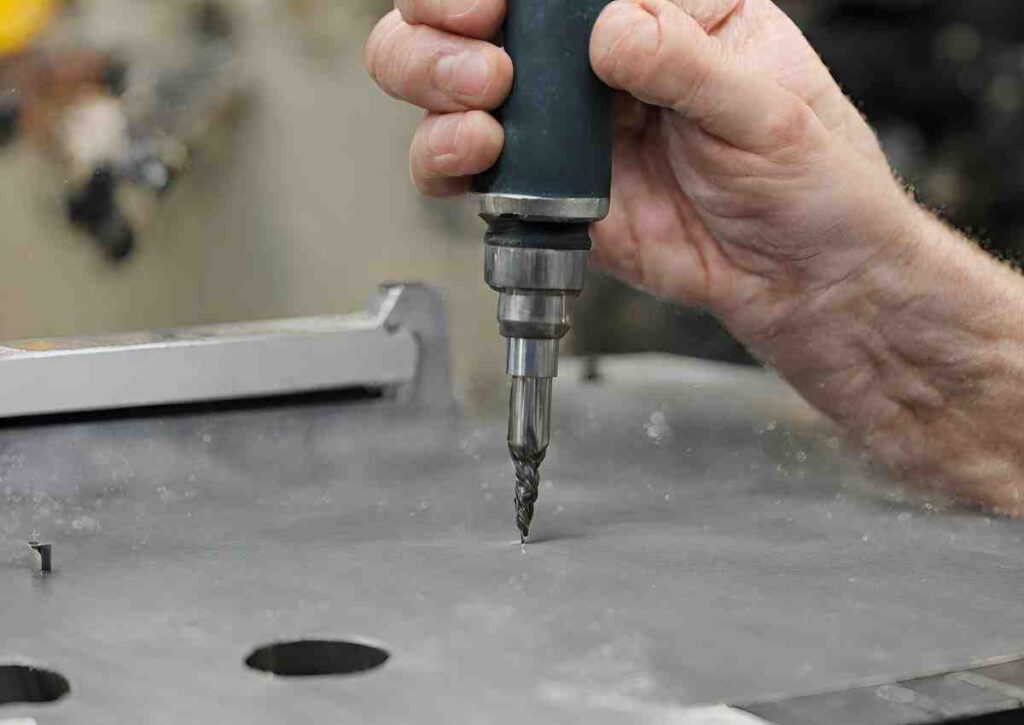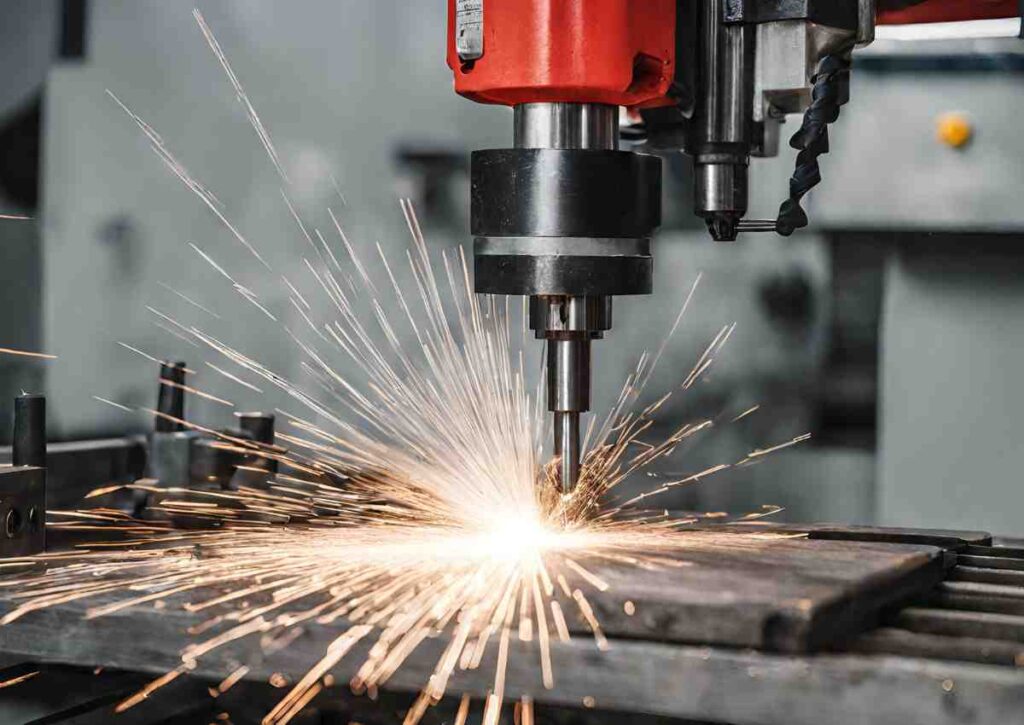Drills may seem similar at first glance, but a closer look reveals distinct purposes between a spotting drill bit and a center drill bit.
Spotting Drill vs Center Drill? A spotting drill makes precise starting points ideal for softer materials like wood, while a center drill is best for accurate starting points in metalworking, ensuring flush screw placements.
In this blog post, I talked about the difference between spotting drills and center drills.
You will need to use a center drill instead of a spot drill to put screws in metal that is flat. Spot holes work better for finding the right place to start in soft materials.
Center Drill: Establishing Precision and Starting Points
A centre drill has a shorter, stronger handle and an end that is tapered or shaped like a cone. Its main job is to mark where to start drilling other holes.
It also helps make sure that screws sit flush with surfaces and don’t catch or grab while they’re being put in place.
It’s great for working with different metals because it’s durable and won’t bend or slide off the drilling target. It’s also sometimes called a combination or countersink drill.
Center Drill Uses: Perfect For Metalworking

- Works Best with Metals: Center drills are great for working with metals like iron, aluminium, steel, and mixtures of metals (called alloys).
- Super Reliable on Metal: They’re really good at keeping things precise when working on metal surfaces. They’re strong and not too long, so they don’t bend much, making sure your drilling is spot on.
- Keeps Things Accurate: Being accurate is super important when making holes, and these drills do a great job at keeping everything accurate and exact.
Spot Drill: Precision In Starting Points
A spot drill, on the other hand, is different because it is thin and doesn’t have the cone-shaped tips that centre drills do.
The best thing about it is how accurate it is, especially when drilling at exact starting points that don’t have any spirals or grooves that could make the hole move.
This design makes it last longer and makes it less likely that it will wobble while it’s being used.
Spot Drill Uses: Versatility And Accuracy
- Spot drills work best with softer metals, wood, and plastic.
- They’re great for tight spaces and won’t harm the material.
- Using a spot drill makes sure that the next drill in the same spot is more accurate.
When to Use Spotting Drill vs Center Drill: Making the Right Choice

Design And Appearance
1. Spot Drills: They are shorter with minimal flutes (grooves along the sides) and often have a stub length.
2. Center Drills: These drills have a shorter, sturdier shaft with a tapered or cone-shaped end.
Function
1. Spot Drills: Primarily used to precisely mark holes for subsequent drilling, ensuring accuracy in drilling placement.
2. Center Drills: Designed to create starting points for drills and ensure screws sit flush with surfaces without catching or grabbing.
Accuracy And Precision
1. Spot Drills: Excellently precise, aiding in drilling holes exactly where intended, particularly useful with specific drill bit angles.
2. Center Drills: Known for their reliability in maintaining precision against metal surfaces and minimizing deviations during drilling.
Materials And Applications
1. Spot Drills: Suitable for softer metals, wood, and plastics due to their precision and versatility.
2. Center Drills: Ideal for working with denser metals like cast iron, aluminum, steel, and alloys, ensuring accuracy during metalworking.
Drill Bit Angles
1. Spot Drills: Particularly beneficial for achieving accuracy with specific drill bit angles, ensuring precise drilling placement.
2. Center Drills: Designed to establish starting points and countersinks with a specific angle, affecting hole accuracy during drilling.
Understanding these differences is crucial in choosing the right tool for specific drilling tasks, ensuring accuracy and precision in metalworking or woodworking applications.
Using Center Drills for Spotting: Pros and Cons
Pros
- Familiar Choice: Lots of people prefer center drills to spot drilling because they’re more familiar with them.
Cons
- Breakage Risk: These drills have a tiny tip that can easily break, causing a stop in drilling, especially if you use them a lot for spot drilling. It’s a big worry in jobs where you’re spotting holes often.
- Alignment Issues: Sometimes, the angle of the center drill’s countersink doesn’t perfectly match the twist drill angles. This mismatch could affect how accurate your holes turn out.
Also Read: How To Drill A Hole In Wood
Choosing Chuck Types: Drill Chuck or Collet Chuck?
Deciding between a drill chuck and a collet chuck for spot drills or twist drills involves balancing accuracy and holding power.
Collet chucks offer precision, while drill chucks concentrate gripping force at specific points, potentially marring the shank of the drill.
Enhance Wear Resistance with Carbide Tools
Considering carbide spot drills and center drills prove beneficial due to their robustness and wear resistance, making them sturdy options for prolonged use.
Spot Drill Tips and Techniques: Maximizing Efficiency

When spot drilling, letting the drill stay at the bottom of the hole for a short time makes sure that the surface is smooth for the next drill.
In addition to drilling holes, spot drills can do other things like chamfering and counterboring, which makes them useful for a variety of machining jobs.
Understanding the distinctions between spot and center drills is vital to achieving precise and accurate drilling results, allowing for efficient and effective operations in both metalworking and woodworking applications.
Conclusion
Center drills and spot drills are used for different things. When drilling metal, center drills work best.
For drilling soft materials, spot drills work best. It helps to know when to use each one when digging.
Center drills are used to make precise holes in steel, and spot drills are great for making precise starting holes. To get those holes where you want them, you need to pick the right one.
Also Read: How To Drill Into Brick In 6 Easy Steps
FAQs
What is the difference between a spot drill and a drill?
A spot drill creates precise starting points without spirals, while a drill makes holes using spirals along its shaft.
What is a spotting drill bit used for?
A spotting drill bit is used to mark precise starting points for subsequent drilling, especially in softer materials like wood or plastic.
What is a center drill used for?
A center drill is primarily used to establish accurate starting points for drilling in metal, ensuring screws sit flush with surfaces.
What are two distinct reasons for using a center drill?
Center drills excel in metalworking due to their precision in establishing starting points, and they ensure screws fit flush with surfaces, avoiding protrusions.









